Bibliography Background About KRIS
Fish populations
Northwestern California river's have few native fish species relative to East Coast rivers or Midwest rivers, like the Mississippi (Moyle, 1976). The rivers of the mid and eastern continent traverse landscapes that have been relatively stable for millions of years, while the West Coast landscape has been fractured by mountain building, rearranged by earthquakes and volcanic eruptions, and buried by ice sheets north of the Columbia basin. Another indication that these streams have only been recently colonized is the low occurrence of endemism. or evolution of unique taxa, with exceptions being roach species in the Gualala, Navarro and Russian rivers. Native fish fauna of northwestern California rivers include several Pacific salmon species, five sculpin, Pacific lamprey, western brook lamprey from Humboldt Bay northward, two sucker species, several native minnows and stickleback. Despite the low number of fish taxa in northern California, however, the fish community structure reflects aquatic health and can be used in watershed analysis (see examples below).
The north coast shares both the Klamath Basin fauna and the Sacramento-San Joaquin fauna (Moyle, 1976) and this is reflected in variations between northern and southern sucker, minnow and sculpin species. Moyle (1976) also identifies three reaches in coastal California fish-bearing streams: 1) headwaters above barriers inhabited by native rainbow trout (or rainbow and coastal cutthroat north of the Eel River), 2) stream reaches accessible to anadromous fish, and 3) inter-tidal areas, lagoons or estuaries. Fish that are tolerant of salt water (euryhalene) inhabit the latter areas, but many different types of marine fishes may also enter larger estuaries to spawn, rear and forage. Green sturgeon and possibly white sturgeon were native to the larger mainstem rivers like the Klamath, Trinity, Eel and Russian. The eulachon, or candlefish, is an anadromous marine species that used lower river reaches for spawning and was present in most larger rivers from San Francisco Bay to Oregon (Moyle, 1976). Larsen and Belchek (1998) noted a dramatic decline of candlefish in the lower Klamath River and Kier Associates (1991) advanced the hypothesis that increased bedload movement and aggradation were likely the cause of their decline.
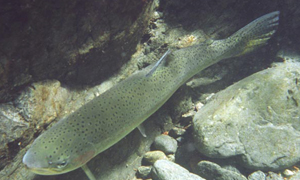 Pacific salmon species that normally inhabit northern California rivers today are steelhead trout, coho salmon, chinook salmon and coastal cutthroat trout from the mouth of the Eel River north. Evermann and Clark (1931) and Snyder (1931) indicate that pink salmon (Oncorhynchus gorbuscha) and chum salmon (Oncorhynchus keta) were also likely native to the northern California Rivers, and Moyle (1976) suggests that these species were wiped out by disturbances brought on by early white settlers. Pacific salmon species are identified as "beneficial uses" regionally under the Clean Water Act, and several are recognized as being at risk of extinction in the region (see Status of Pacific Salmon Species in Northwestern California).
Pacific salmon species that normally inhabit northern California rivers today are steelhead trout, coho salmon, chinook salmon and coastal cutthroat trout from the mouth of the Eel River north. Evermann and Clark (1931) and Snyder (1931) indicate that pink salmon (Oncorhynchus gorbuscha) and chum salmon (Oncorhynchus keta) were also likely native to the northern California Rivers, and Moyle (1976) suggests that these species were wiped out by disturbances brought on by early white settlers. Pacific salmon species are identified as "beneficial uses" regionally under the Clean Water Act, and several are recognized as being at risk of extinction in the region (see Status of Pacific Salmon Species in Northwestern California).
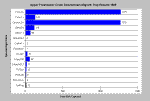 This chart shows the results of downstream migrant trapping on Freshwater Creek, a tributary of Humboldt Bay, in northern California, for the year 1989. This watershed is forested by redwoods which had not been harvested for at least 50 years. Note that there are four species of Pacific salmon (Stlhd = steelhead, Cutthrt = cutthroat trout). Note also that Pacific lamprey adults (Lmpry Ad) and ammocetes (Lmpry Am) and brook lamprey (BrkLampry) were present in addition to smaller numbers of sculpin and stickleback. Although Pacific giant salamanders are common in northern California coastal streams, the presence of tailed frogs indicate a fairly intact forest canopy and ecosystem upstream at that time (see Amphibians). The data suggests that the stream had come back into sediment equilibrium after 50-80 years watershed rest, and pool depth had recovered sufficiently to support coho juveniles. Accounts from the late 1940's suggest that chum and summer steelhead were also present in Freshwater Creek (Higgins, 2002). Data from Humboldt Fish Action Council.
This chart shows the results of downstream migrant trapping on Freshwater Creek, a tributary of Humboldt Bay, in northern California, for the year 1989. This watershed is forested by redwoods which had not been harvested for at least 50 years. Note that there are four species of Pacific salmon (Stlhd = steelhead, Cutthrt = cutthroat trout). Note also that Pacific lamprey adults (Lmpry Ad) and ammocetes (Lmpry Am) and brook lamprey (BrkLampry) were present in addition to smaller numbers of sculpin and stickleback. Although Pacific giant salamanders are common in northern California coastal streams, the presence of tailed frogs indicate a fairly intact forest canopy and ecosystem upstream at that time (see Amphibians). The data suggests that the stream had come back into sediment equilibrium after 50-80 years watershed rest, and pool depth had recovered sufficiently to support coho juveniles. Accounts from the late 1940's suggest that chum and summer steelhead were also present in Freshwater Creek (Higgins, 2002). Data from Humboldt Fish Action Council.
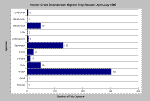 This 1990 downstream migrant trap data collected in Hunter Creek, tributary to the lower Klamath River, shows a fish community dominated by warm water fish and sculpin, not salmonids. Reeves et al. (1993) found that Pacific salmon species diversity in Oregon coastal streams dropped in response to logging in over 25% of a watershed's area. The Hunter Creek watershed has been more than 80% logged. Species such as dace, suckers and stickleback can withstand warmer water temperatures associated with aggradation and stream widening.
This 1990 downstream migrant trap data collected in Hunter Creek, tributary to the lower Klamath River, shows a fish community dominated by warm water fish and sculpin, not salmonids. Reeves et al. (1993) found that Pacific salmon species diversity in Oregon coastal streams dropped in response to logging in over 25% of a watershed's area. The Hunter Creek watershed has been more than 80% logged. Species such as dace, suckers and stickleback can withstand warmer water temperatures associated with aggradation and stream widening.
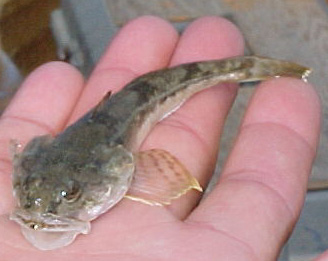 Sculpin are flat-bodied fish, which live amongst cobble and gravel. Prickly sculpin, riffle sculpin and Coast Range sculpin may all be found in north coast streams. Maahs (1996) found very high numbers of sculpin relative to salmonids in intensively logged tributaries of the Ten Mile River. The habit of laying adhesive eggs on the underside of logs or rocks (Moyle, 1995) may make them less vulnerable to sediment problems that limit salmonids. Sculpin may also be slightly more resistant to increased water temperature than salmonids (see chart below).
Sculpin are flat-bodied fish, which live amongst cobble and gravel. Prickly sculpin, riffle sculpin and Coast Range sculpin may all be found in north coast streams. Maahs (1996) found very high numbers of sculpin relative to salmonids in intensively logged tributaries of the Ten Mile River. The habit of laying adhesive eggs on the underside of logs or rocks (Moyle, 1995) may make them less vulnerable to sediment problems that limit salmonids. Sculpin may also be slightly more resistant to increased water temperature than salmonids (see chart below).
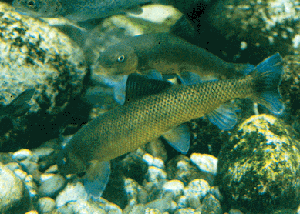 The Sacramento sucker is the species found from Redwood Creek south, while the Klamath small scale sucker (Catostomas rimiculus) occurs in drainages from the Klamath River north. Suckers prefer the lazy current of mainstem coastal rivers to steep, tumbling headwater streams. The profound changes of north coast rivers in response to sedimentation from the 1955 and 1964 flood lead to a large increase in sucker populations companion with the decline of salmonids (German, 1968). In cases where there are chronic high levels of turbidity and bedload movement, suckers may decline or disappear, such as in the Gualala River (Higgins, 1997).
The Sacramento sucker is the species found from Redwood Creek south, while the Klamath small scale sucker (Catostomas rimiculus) occurs in drainages from the Klamath River north. Suckers prefer the lazy current of mainstem coastal rivers to steep, tumbling headwater streams. The profound changes of north coast rivers in response to sedimentation from the 1955 and 1964 flood lead to a large increase in sucker populations companion with the decline of salmonids (German, 1968). In cases where there are chronic high levels of turbidity and bedload movement, suckers may decline or disappear, such as in the Gualala River (Higgins, 1997).
 This chart of electrofishing results from the Wheatfield Fork Gualala River shows a fish community structure characteristic of a temperature impaired stream. The California roach is one of the most widespread native minnows in California. Both the Russian and Gualala rivers have evolved their own species of endemic species of roach. These fish may survive in waters up to 95 degrees Fahrenheit and they usually dominate fish samples in warmer streams. Roach were probably a minor part of the fish community of the redwood region before disturbance, using slow, warm side channels or ponds on terraces of larger rivers for habitat. Stickleback are ubiquitous in ponds, streams, estuaries and even ditches of northern California. This species has a fairly wide temperature tolerance, and may even exhibit an anadromous life history.
This chart of electrofishing results from the Wheatfield Fork Gualala River shows a fish community structure characteristic of a temperature impaired stream. The California roach is one of the most widespread native minnows in California. Both the Russian and Gualala rivers have evolved their own species of endemic species of roach. These fish may survive in waters up to 95 degrees Fahrenheit and they usually dominate fish samples in warmer streams. Roach were probably a minor part of the fish community of the redwood region before disturbance, using slow, warm side channels or ponds on terraces of larger rivers for habitat. Stickleback are ubiquitous in ponds, streams, estuaries and even ditches of northern California. This species has a fairly wide temperature tolerance, and may even exhibit an anadromous life history.
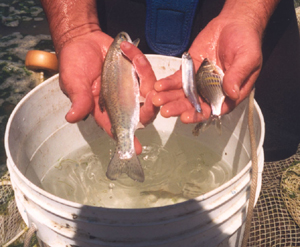 Estuaries and lagoons may be important habitat seasonally for salmon and steelhead, but many other fish visit these areas for spawning and juveniles subsequently use them as nursery habitat. The photo at left shows a sample from the Garcia River estuary in an area that had a mixture of salt and freshwater, which includes a steelhead smolt, a surf smelt and shiner surf perch. Other common visitors to estuaries are starry flounder, bay pipefish, anadromous Pacific staghorn sculpin, stickleback, Pacific herring and several other species of perch.
Estuaries and lagoons may be important habitat seasonally for salmon and steelhead, but many other fish visit these areas for spawning and juveniles subsequently use them as nursery habitat. The photo at left shows a sample from the Garcia River estuary in an area that had a mixture of salt and freshwater, which includes a steelhead smolt, a surf smelt and shiner surf perch. Other common visitors to estuaries are starry flounder, bay pipefish, anadromous Pacific staghorn sculpin, stickleback, Pacific herring and several other species of perch.
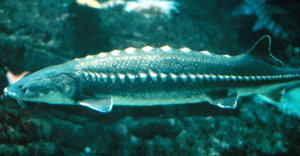 The most ancient of species inhabiting northern California rivers are the sturgeon and the lamprey. Green sturgeon return to the Klamath and Trinity, but other rivers like the Eel may have lost their runs and this species has been petitioned for listing under the Endangered Species Act. Pacific lamprey inhabit coastal streams all the way down to southern California, and they are joined by a smaller cousin the western brook lamprey. Pacific lamprey can ascend steeper streams than steelhead, but they must live in freshwater as blind larvae in stable pockets of fine sediment for four years before going to the ocean and changing to the adult, parasitic form. Deterioration of freshwater habitat is causing concern that lamprey may be declining similarly to Pacific salmon species (Larsen and Belchek, 1998).
The most ancient of species inhabiting northern California rivers are the sturgeon and the lamprey. Green sturgeon return to the Klamath and Trinity, but other rivers like the Eel may have lost their runs and this species has been petitioned for listing under the Endangered Species Act. Pacific lamprey inhabit coastal streams all the way down to southern California, and they are joined by a smaller cousin the western brook lamprey. Pacific lamprey can ascend steeper streams than steelhead, but they must live in freshwater as blind larvae in stable pockets of fine sediment for four years before going to the ocean and changing to the adult, parasitic form. Deterioration of freshwater habitat is causing concern that lamprey may be declining similarly to Pacific salmon species (Larsen and Belchek, 1998).
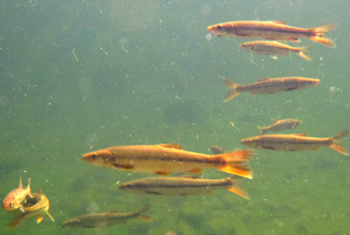 Introduction of exotic fish species is a major problem in some northern California rivers, especially those with serious ecological problems. Humans have induced wholesale changes in aquatic ecosystems, such as turning the Eel River into a warm shallow stream versus a deep, cold one, and then introduced exotic species well adapted to the new conditions. While the larger predatory minnow, the northern pike-minnow, is native to the Russian River, its introduction into the Eel River basin has caused major problems. Common introduced species are largemouth bass (Mycropterus salmoides), green-eared sunfish (Lepomis cyanellus) and cat fish (Ictalurus sp.).
Introduction of exotic fish species is a major problem in some northern California rivers, especially those with serious ecological problems. Humans have induced wholesale changes in aquatic ecosystems, such as turning the Eel River into a warm shallow stream versus a deep, cold one, and then introduced exotic species well adapted to the new conditions. While the larger predatory minnow, the northern pike-minnow, is native to the Russian River, its introduction into the Eel River basin has caused major problems. Common introduced species are largemouth bass (Mycropterus salmoides), green-eared sunfish (Lepomis cyanellus) and cat fish (Ictalurus sp.).
Methods Used to Study Salmon and Steelhead Populations
References
Evermann, B. W., and H. W. Clark. 1931. A distributional list of the species of freshwater fishes known to occur in California. Calif. Department of. Fish and Game Fisheries Bulletin. No. 35.
Higgins, P.T. 1997. Gualala River Watershed Literature Search and Assimilation. Funded by the Coastal Conservancy under contract to Redwood Coast Land Conservancy. Gualala, CA. 59 pp.
Kier Associates. 1991. Long Range Plan for the Klamath River Basin Conservation Area Fishery Restoration Program. Klamath River Basin Fisheries Task Force. Yreka, CA.
Larson, Z.S. and M.R. Belchik. 1998. A preliminary status review of eulachon and Pacific lamprey in the Klamath River Basin. Yurok Tribal Fisheries Program. Klamath CA. 24 p.
Moyle, P.B. 1976. Inland Fishes of California. University of California Press, Berkeley, CA.
Snyder, J. 0. 1931. Salmon of the Klamath River, California. Calif. Department of Fish and Game Fisheries Bulletin No. 34.
